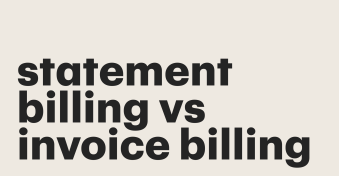When you’re sending electronic documents, capturing an electronic signature is a critical component that can’t be overlooked.
Signers need (and expect) a quick and easy way to return your documents with the appropriate e-signature in order to move the deal forward.
In the past, only a few cloud-based signature software solutions offered a comprehensive user experience.
However, today’s modern e-signature market is more competitive than ever. Small businesses have a number of great solutions to choose from.
In this article, we’ll be comparing two of them: DocuSign vs SignNow.
Ready? Let’s hop right in.
Key takeaways
- DocuSign offers the premier signing experience but keeps its scope narrow. Other tools, like DocuSign CLM and Gen exist as standalone products with an extra price tag.
- signNow is part of the airSlate Workflow platform and can be purchased as a standalone signing service or as part of the entire airSlate automation platform.
- signNow offers live chat support, a notable feature considering DocuSign’s ticket-based response system.
- Both plans lock their CRM integrations behind enterprise-level plans, so expect to pay a premium to connect to your customer data.
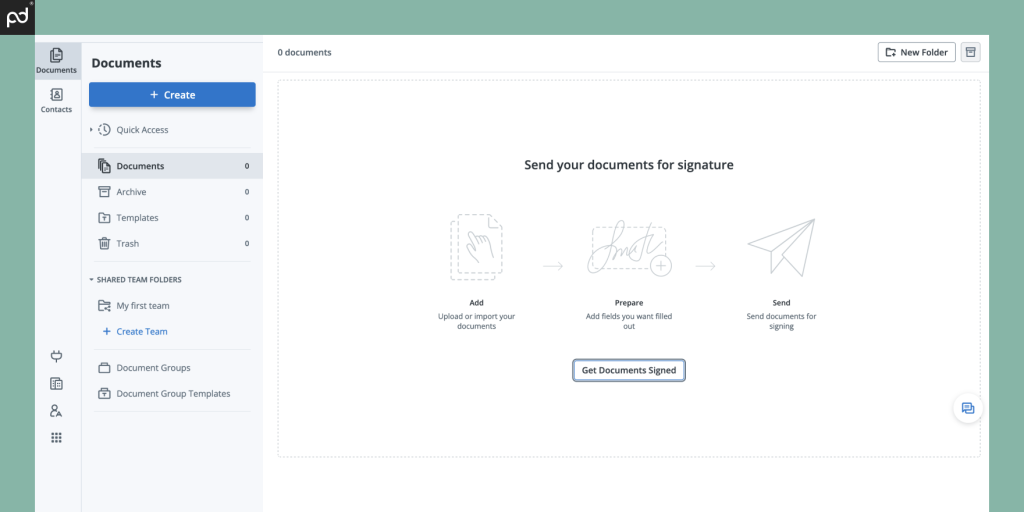
1. SignNow
Pricing: Business ($20); Business Premium ($30); Enterprise ($50).
Enterprise pricing (called “Business Cloud”) available. All pricing based on month-to-month commitment.
Ease of use: 9.1/10
Free trial: Yes; 30 days.
Support: Knowledge base; support tickets; phone.
Since launching in 2011, signNow has changed hands a few times.
In its latest iteration, the tool has been folded into the airSlate platform as the automation platform’s “go-to” signing solution.
To be clear: It’s not necessary to buy into the entire airSlate environment in order to take advantage of signNow.
It can be sold as a standalone product, and that provides the clearest comparison to DocuSign.
As a singular tool, signNow offers a strong signing solution with most of the standard features you would expect from a DocuSign competitor.
Document preparation is fast and easy, and your plan will determine what sending features are available to you.
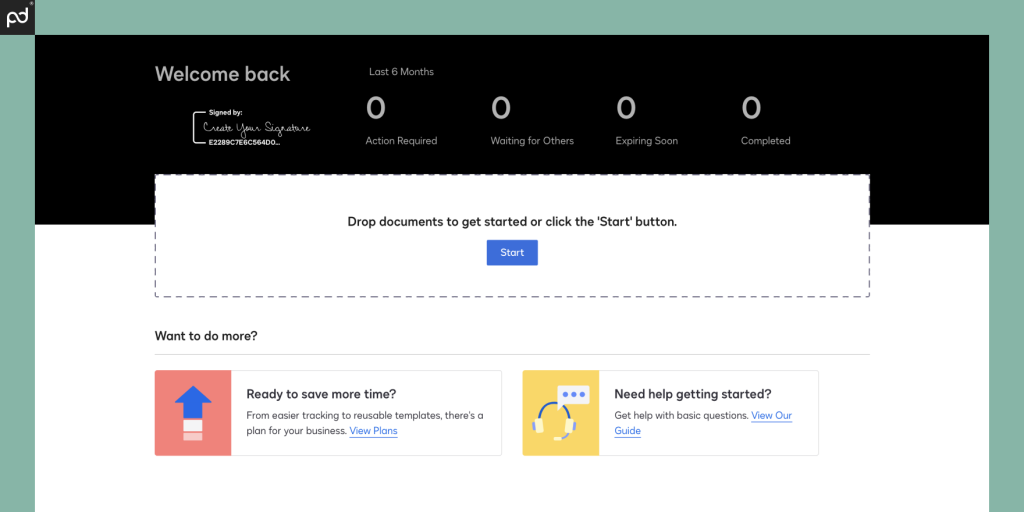
2. DocuSign
Pricing: Personal ($15); Standard ($45); Business Pro ($60).
Real estate and Enterprise pricing available. All pricing based on month-to-month commitment.
Ease of use: 9.0/10
Free trial: Yes; 30 days.
Support: Knowledge base, support tickets; additional support plans sold as separate packages.
The reigning champion for digital e-signature capture, DocuSign is the signing platform that most people already know and understand.
While other companies have iterated on DocuSign’s success in a variety of ways (for example, by providing a suite of end-to-end content creation and e-signing tools), DocuSign is an excellent example of a narrowly focused product that executes at a very high level.
Its success has been so widespread that you’ll see similar signing workflows in nearly every competitor — and signNow is no exception.
If you’re looking for a one-and-one signing solution, DocuSign gives you all the tools you’ll need.
However, keep in mind that you may get more for your money with other platforms, who want you to choose their signing process over one of the industry standards.
DocuSign vs SignNow at a glance
| Plan Details | DocuSign | SignNow |
|---|---|---|
| Plan Name | Business Pro | Enterprise |
| Core product | ||
| E-signature capture | ✔︎ | ✔︎ |
| Real-time audit trail | ✔︎ | ✔︎ |
| Notifications | ✔︎ | ✔︎ |
| Language support | ✔︎ | ✔︎ |
| Mobile app (Android or iOS) | ✔︎ | ✔︎ |
| Reporting tools | ✔︎ | ✔︎ |
| E-signing features | ||
| Signing order | ✔︎ | ✔︎ |
| Send to multiple recipients | ✔︎ | ✔︎ |
| Bulk send | ✔︎ | ✔︎ |
| In-person signing | ✔︎ | ✔︎ |
| Collaboration tools | ✔︎ | Limited |
| Signer attachments | ✔︎ | ✔︎ |
| Payment gateway | ✔︎ | ✔︎ |
| Document prep | ||
| Drag & drop fields (PDF) | ✔︎ | ✔︎ |
| Create reusable templates | ✔︎ | ✔︎ |
| From-scratch document builder | ✕ | ✕ |
| Pre-built template library | ✕ | ✕ |
| Form creation | ✔︎ | ✔︎ |
| Custom branding | ✔︎ | ✔︎ |
| Integrations & API | ||
| Import & storage | ✔︎ | ✔︎ |
| CRM | ✕ | ✕ |
| Productivity | ✔︎ | Limited |
| API | $ | ✕ |
| Support | ||
| Email / ticketing support | ✔︎ | ✔︎ |
| Chat support | ✕ | ✔︎ |
| Knowledge base | ✔︎ | ✔︎ |
| Phone | ✕ | ✕ |
| Premium support options | $ | ✕ |
Both DocuSign and signNow offer plans above the professional options featured here.
At the enterprise level, both platforms provide connectivity to a variety of CRM integrations and compliance functionality.
Realistically, DocuSign is a winner at the enterprise level unless you’re interested in scaling into the airSlate Business Cloud, which provides access to an entirely new suite of tools.
The price tag for the Business Cloud is substantially more expensive than anything DocuSign offers because it requires a five-seat minimum at $50/month per user — roughly $250/month to start!
Final note: If Business Cloud still isn’t enough, airSlate Workflow is your next stop.
The Enterprise plan via Workflow runs $399/month but is counted using credit (not user seats) and has most of the signNow functionality built in.
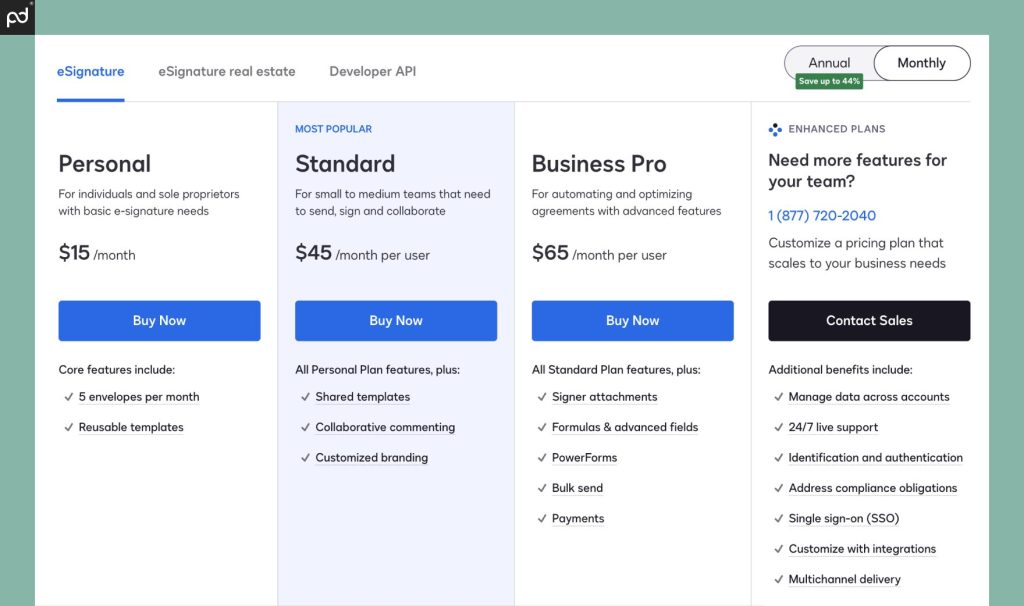
Plans & basic features
At first glance, you won’t find much daylight between the majority of the pre-enterprise-level plans for DocuSign and signNow.
Functionally, the plans offered by both companies provide similar features and performance across a variety of pricing tiers.
The similarity is particularly obvious for Business Pro and Enterprise plans (compared above), where the basic functionality in the platform is already provided.
At higher levels, the key difference comes down to the tools at your disposal to scale your signing operations quickly.
Lower-end plans will lack bulk send functionality, payment gateways, and nice-to-haves like signer attachments.
Both DocuSign and signNow follow the same mentality when it comes to integrations, too.
Neither plan provides CRM integrations until the enterprise level, meaning that your signing platform is forced to stand apart from the customer data in your tech stack unless you’re willing to pay premium prices.
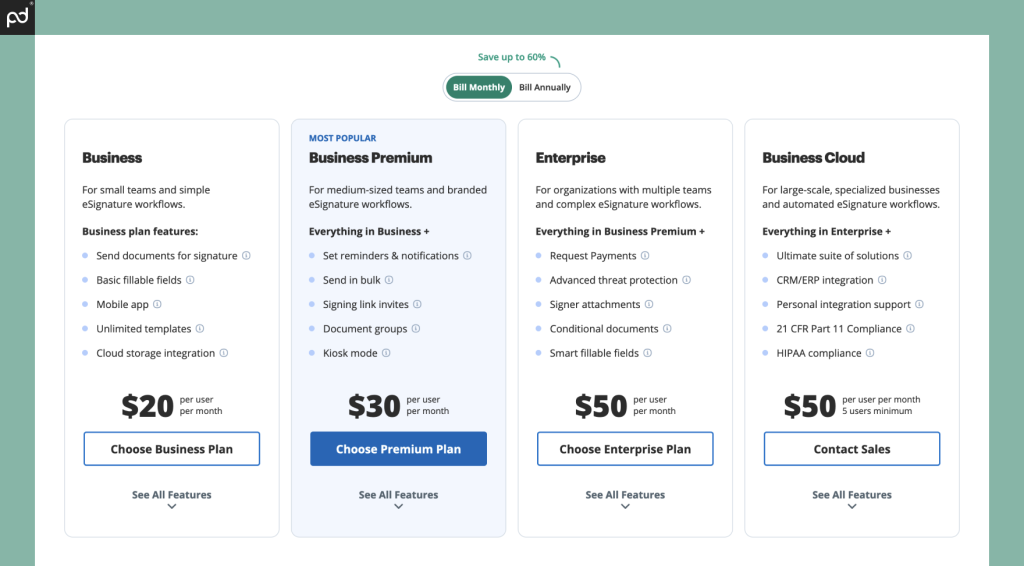
However, it’s worth pointing out that this isn’t standard across the industry.
PandaDoc provides integration options for a variety of CRMs — including Salesforce — at the pre-enterprise level), as do a selection of other signing platforms.
Those options do exist if you want earlier integration options (useful for single-seat users and small departments who want to keep overhead low), but you won’t find them here.
All that said, signNow isn’t trying to be a DocuSign knockoff. The platform simply uses a tried and tested process to create a digitization workflow that is easy to set up and use.
For signNow users, that’s not a bad thing considering that signNow offers its annual plan at a substantially lower cost when compared to DocuSign.
Our suggestion
Because the feature set between signNow and DocuSign is so similar, we’d suggest considering your long-term goals in terms of scalability.
If you aren’t starting there, do you see yourself moving to an enterprise-level plan?
With signNow, that jump would require a switch from $30/month (Enterprise plan) to $250/month (Business Cloud), due to the five-seat minimum.
That’s a significant jump compared to DocuSign, where you could feasibly take a single seat onto an Enhanced Plan for a custom solution tailored to your needs and use case.
As we mentioned earlier, keep in mind that neither of these is the only option.
Other platforms, like PandaDoc, provide different features and integration options that offer a new perspective on the e-signing and CLM process.
Final verdict:
- Both plans offer similar features at the pre-enterprise level, but pricing and features vary greatly once you move beyond the standard plans.
- signNow offers more affordable plans at every level except Enterprise, where the five-seat requirement skyrockets the price to a $250/month minimum.
PandaDoc and others signing platforms may provide more holistic document workflows and robust integration options without the costs associated with an enterprise-level plan.
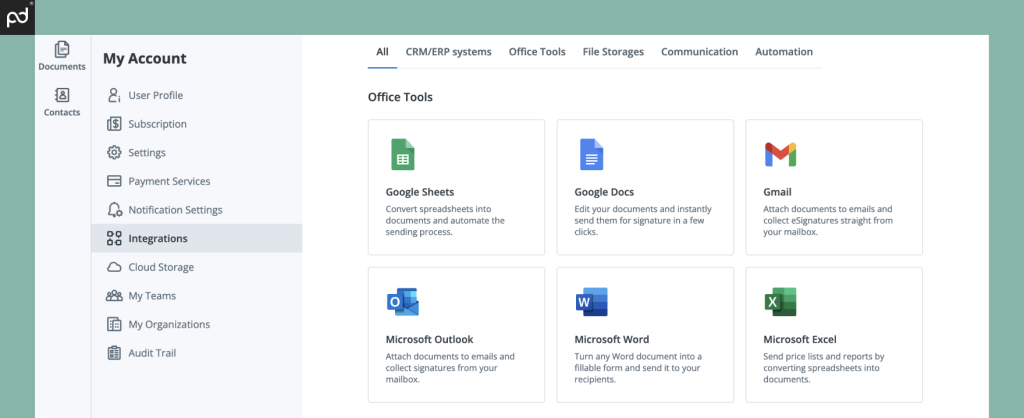
Automation tools
At higher pricing tiers, one of the key differences between DocuSign and signNow comes down to the implementation of automation tools like webforms and conditional routing.
While both companies offer standard automation tools like templates and conditional fields to help senders swiftly gather critical information, advanced features are usually locked behind DocuSign’s Business Pro or signNow’s Enterprise (plan) level.
To start, DocuSign’s Business Pro plan introduces both PowerForms and webforms, two similar types of self-service documents that you can use to automate data capture.
Both form types can be embedded on a website and will allow customers to quickly submit requested information.
This feature is largely unique to DocuSign.
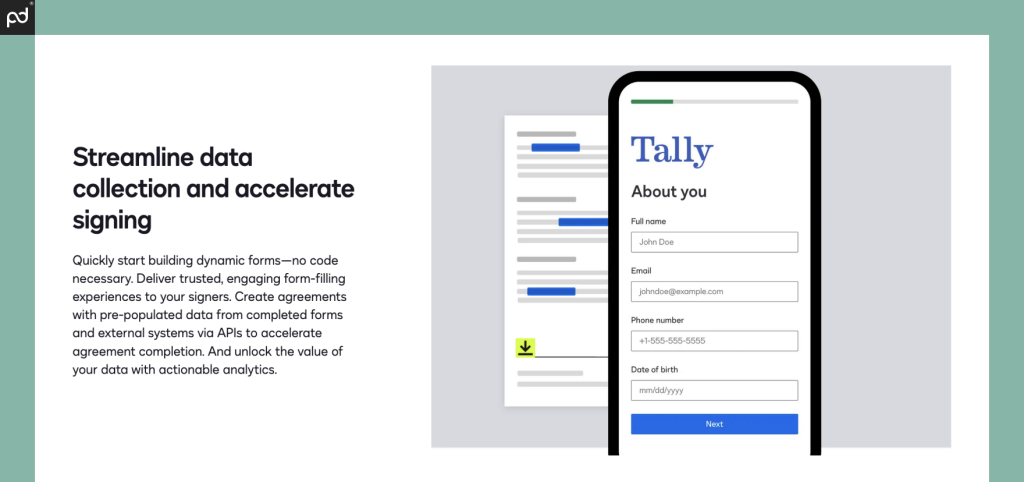
It’s technically possible to replicate this functionality with SignNow, but it can only be done through an API call (min. $84/month w/ annual commitment).
You could also do something similar with PandaDoc API, which offers similar functionality via REST and/or webhook services.
By contrast, DocuSign allows users to utilize forms on the signing plan, but submissions are counted against the envelope or transaction limit (more on this below).
On the other hand, signNow offers conditional routing on the Enterprise plan while DocuSign users will need to upgrade for the same toolkit.
This feature allows senders to designate the order in which documents can be signed.
It’s a powerful tool that helps senders guarantee compliance during the digital signature process by ensuring that documents can’t be signed in the wrong order.
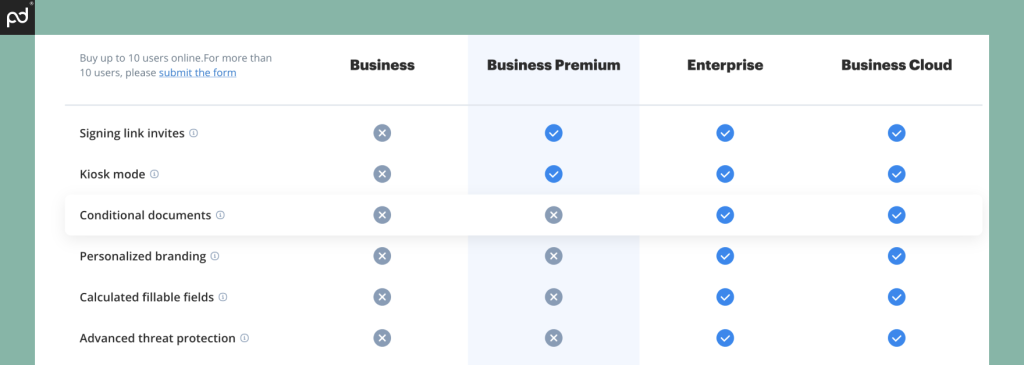
It’s worth pointing out that all of the automation features from both companies are largely concerned with the preparation and dispatch of documents.
However, neither company is equipped to handle document production like we do at PandaDoc, where our built-in content library and smart content tools help you to build custom, personalized documents in minutes before dispatching them for data collection and e-signature.
Our suggestion
While both signNow and DocuSign have similar automation features, the tools you can access will be determined by the plan you choose.
With a few exceptions, both companies offer similar features in the same tier.
At the same time, both platforms lack tools to assist with document creation.
If you’re looking for ways to quickly customize and format documents beyond basic drag-and-drop formatting tools, you’ll need to look elsewhere.
Final verdict:
- DocuSign users on the Business Pro plan can take advantage of form generation tools and embedding, which allows for rapid data collection via websites and shared links.
- signNow users on the Enterprise plan get access to conditional document routing, which helps to control the order in which documents are signed. DocuSign users won’t get this without a custom plan.
Neither company offers options to help with surgical content customization during production.
For that, you’ll need a tool like PandaDoc, which offers an onboard document editor and content library in addition to form generation.

Transaction limits
Usage is one of the most important factors when choosing your signing platform.
Although it’s not always obvious, many e-signing tools have a usage cap that limits your ability to send documents to recipients.
This usage is tracked internally, and overages can lead to extra charges or force users to purchase additional tokens.
At DocuSign, usage tokens are called envelopes, and they act as a wrapper for your documents, just like a physical envelope.
The trick is in how the envelopes are counted. Essentially, each time you press the “Send” button, an envelope is consumed.
Each one of these actions consumed one envelope:
- Sending one document to one user.
- Sending five documents to one user at the same time.
- Sending five documents to 10 users at the same time.
However, if you send items separately (five documents to one user, sent individually), each send will consume a different envelope.
It’s tricky, but it’s important to remember because DocuSign only provides 100 envelopes per user/year.
This limit means that you’ll run the risk of an additional charge if you send too many documents on the DocuSign platform.
Unfortunately, signNow has similar restrictions.
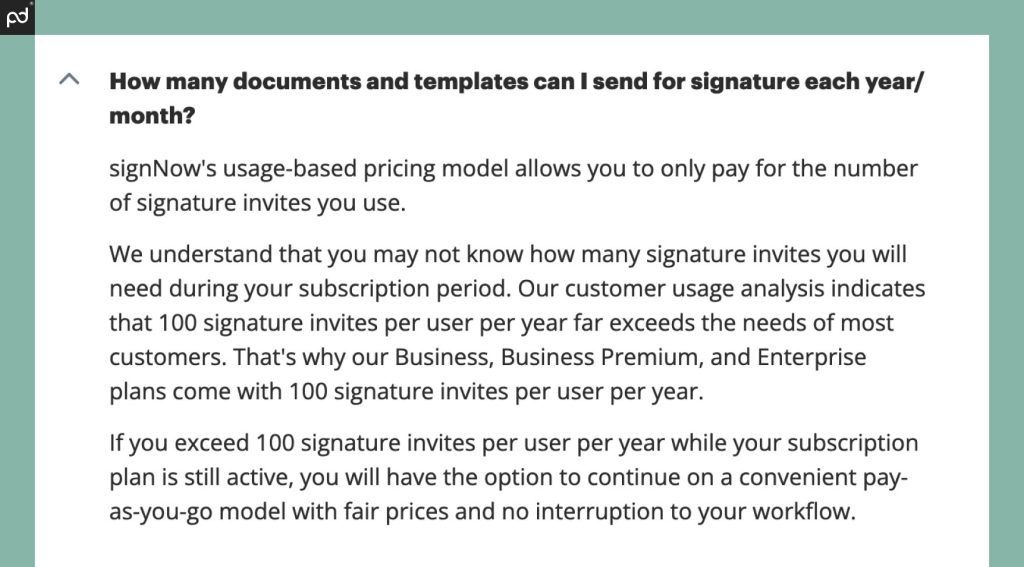
At signNow, accounts are based on pay-as-you-go usage and start with an initial 100 invites on the plan.
If you exceed the standard usage allotment, you’ll need to purchase additional invites.
Both companies are quick to point out that 100 documents per user/year is more than enough for most users.
However, for dedicated teams sending out a high volume of documents (proposals, contracts, NDAs, etc.), envelope totals can quickly add up.
Our suggestion
While DocuSign’s signing tools have helped to shape the e-signing industry, their transaction limits have also set the speed limit for users.
In this instance, signNow has an identical usage cap.
Fortunately, not every company imposes the same restrictions.
At PandaDoc we don’t impose usage restrictions on our standard plans, meaning that users can send documents as they see fit, without worrying about the logistics and rules behind bundles.
Final verdict:
- DocuSign and signNow users are limited to 100 envelopes/invites per user/year. Overages can be negotiated with the sales team but will result in a price increase for the plan.
- PandaDoc doesn’t restrict usage, meaning that you’ll be able to send as many documents as you want, at whatever frequency or configuration you prefer, without worrying about overages.
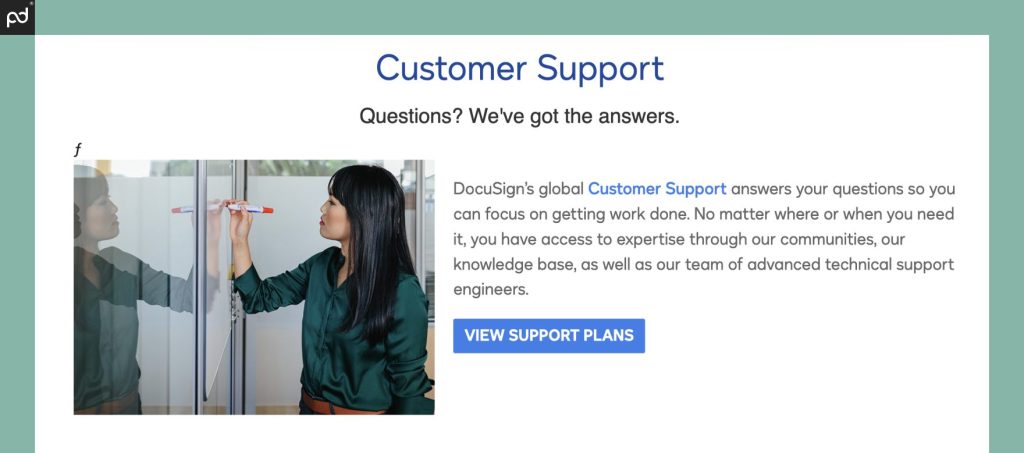
Customer support
While it’s sometimes considered a nice-to-have, support is essentially when you need it.
Whether you have a usage question about platform functionality or you encounter a bug, having support options ready to hand can help you stay productive.
For DocuSign users, support is handled through a ticketing system with a standard 24-hour response time.
A knowledge base is also available for self service. However, if you need help, expect a delay while your ticket is processed and addressed.
It’s possible to lower response times and enable additional access to support by purchasing a DocuSign Support Plan.
This will incur an extra charge on top of your standard DocuSign pricing plan but, at the maximum tier, can reduce response times to as little as two hours, add access to phone support, and more.
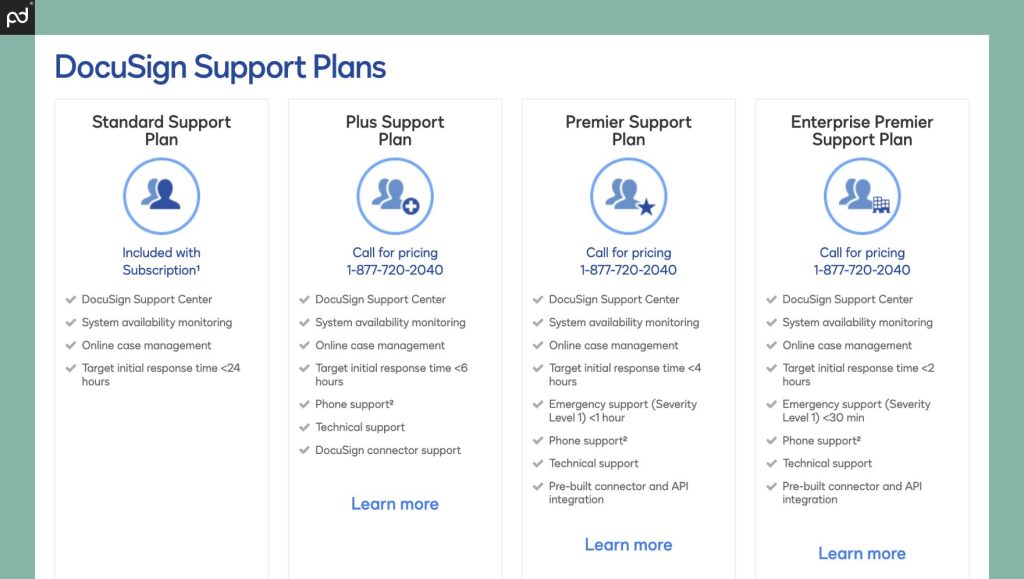
By comparison, signNow automatically offers live chat support for every plan, so you can get in touch with someone quickly when you need assistance.
This is the default support solution until you reach the Business Cloud plan, which offers phone support, as well as personal integration support from the team.
That’s a huge difference in availability, and it’s built directly into the plan.
Our suggestion
At PandaDoc, we feel strongly about user access to assistance. It’s why we offer 24/7 live chat support in addition to premium support options for users who want extra help.
From our point of view, signNow is the clear winner.
Having access to user support quickly is critical during peak productivity periods.
Nobody enjoys delays because they’ve encountered a bug or can’t find the right solution in the knowledge base.
Final verdict:
- DocuSign provides both the least desirable support experience. At lower tiers, expect long delays while your tickets wait in the queue. At the highest tiers, you’ll still experience delays, but you’ll have access to additional options that help you resolve issues quickly.
- signNow and PandaDoc both offer live chat support solutions that put you in contact with an agent immediately. At higher tier plans (signNow) or with premium support options (PandaDoc), you’ll gain access to phone support, account managers, and more.
Alternatives to SignNow & DocuSign
Without a doubt, both signNow and DocuSign provide a user-friendly way to sign documents with ease.
Unfortunately, these e-signature solutions leave some things to be desired around document management and preparation.
Thankfully, other companies also offer e-signature solutions.
Alternative signing options are available for individuals who might need different signing tools and customization options.
Here’s a quick list of signNow/DocuSign alternatives to consider.
If you’re looking for more alternatives, we’ve also compiled competitor lists for both signNow and DocuSign.
Depending on your needs, your preferred signing solution might vary. Many solutions offer a similar toolkit while placing emphasis on certain elements.
For example, OneSpan Sign and DocHub focus on signer authentication and document security.
Meanwhile, PandaDoc and Adobe Sign products provide unparalleled editing capabilities and document control.
You’ll also find variation.
Most platforms offer some level of HIPAA compliance, but the plan you need and the steps you need to take to ensure those requirements will change slightly between e-signature platforms.
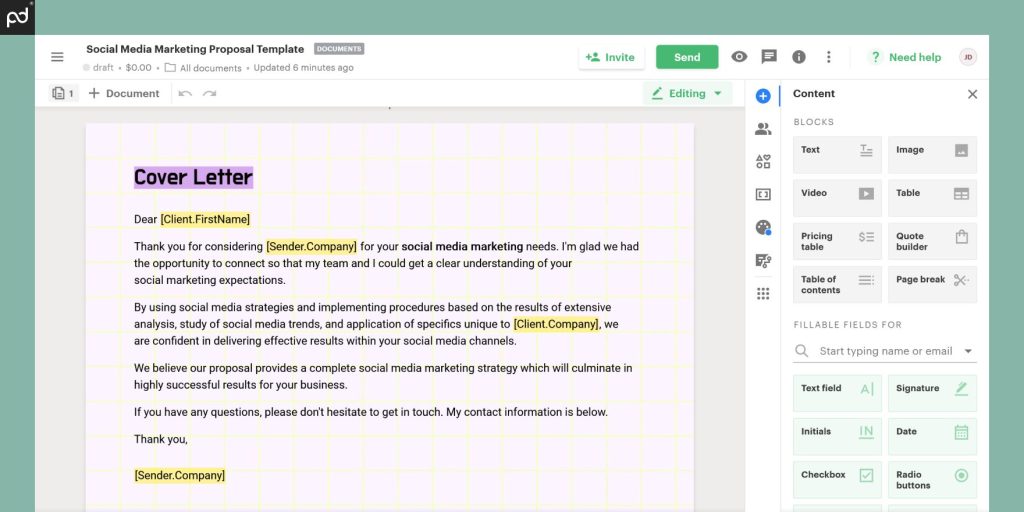
The best document solution: PandaDoc
No doubt: Both DocuSign and signNow bring a lot to the table when it comes to streamlining the e-signing process, however, there are a few shortcomings we noticed.
- DocuSign simplifies the e-signing process but does little to assist with document preparation beyond the absolute basics. Integrations require an enterprise plan, and support options leave something to be desired.
- signNow offers a similar signing solution to DocuSign, but provides a better scope of support at all levels.
- Both platforms limit usage via transaction limits, requiring users to pay extra when sending more than 100 documents in a year. (Fewer than 10/month, if you’re counting.)
From our perspective, e-sign solutions work best when they’re integrated with other aspects of document creation.
Rather than writing your contracts in Google Drive or Microsoft Word and managing them in Box or OneDrive before uploading them to your signing platform, why not handle all of that in one place?
(Full disclosure: PandaDoc users can still use all the tools we just listed as part of the document creation and management process.)
PandaDoc provides all the tools you need to create docs from scratch — in whatever way makes the most sense for your paperless workflow.
With fillable forms, signature fields, and automation tools, we’ve got everything you need and more.
Sign up for a custom demo or test drive our Business plan with a 14-day trial and explore how PandaDoc can change your entire document process.
Disclaimer
Parties other than PandaDoc may provide products, services, recommendations, or views on PandaDoc’s site (“Third Party Materials”). PandaDoc is not responsible for examining or evaluating such Third Party Materials, and does not provide any warranties relating to the Third Party Materials. Links to such Third Party Materials are for your convenience and does not constitute an endorsement of such Third Party Materials.
Originally published April 8, 2020, updated March 25, 2024


